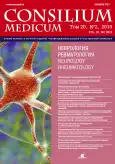Концентрация фибронектина в прогнозе выживаемости и развития симптомной геморрагической трансформации у больных с ишемическим инсультом при проведении тромболитической терапии
- Авторы: Лянг О.В.1, Кочетов А.Г.2, Архипкин А.А.1, Новоженова Ю.В.1, Шачнев Е.Н.3, Шамалов Н.А.4, Стаховская Л.В.1
-
Учреждения:
- ФГБОУ ВО «РНИМУ им. Н.И.Пирогова»
- ФГБОУ ВО «РНИМУ им. Н.И.Пирогова», ФГБУ «НМИЦ кардиологии», АНО ДПО «Институт лабораторной медицины»
- АНО ДПО «Институт лабораторной медицины»
- НИИ цереброваскулярной патологии и инсульта, ФГБОУ ВО «РНИМУ им. Н.И.Пирогова»
- Выпуск: Том 20, № 2 (2018)
- Страницы: 8-13
- Раздел: Статьи
- URL: https://journals.rcsi.science/2075-1753/article/view/94972
- DOI: https://doi.org/10.26442/2075-1753_2018.2.8-13
- ID: 94972
Цитировать
Полный текст
Аннотация
Полный текст
Открыть статью на сайте журналаОб авторах
Ольга Викторовна Лянг
ФГБОУ ВО «РНИМУ им. Н.И.Пирогова»
Email: o.lyang@fedlab.ru
канд. биол. наук, доц. каф. госпитальной терапии с курсом клинической лабораторной диагностики, врач клинической лабораторной диагностики НИИ цереброваскулярной патологии и инсульта 117198, Russian Federation, Moscow, ul. Miklukho-Maklaya, d. 6
Анатолий Глебович Кочетов
ФГБОУ ВО «РНИМУ им. Н.И.Пирогова», ФГБУ «НМИЦ кардиологии», АНО ДПО «Институт лабораторной медицины»
Email: kochetov.lab@yandex.ru
д-р мед. наук, зав. отд. НИИ цереброваскулярной патологии и инсульта, зам. генерального дир., ректор 117997, Russian Federation, Moscow, ul. Ostrovitianova, d. 1
Александр Алексеевич Архипкин
ФГБОУ ВО «РНИМУ им. Н.И.Пирогова»
Email: arhipkin@yahoo.com
канд. биол. наук, науч. сотр. НИИ цереброваскулярной патологии и инсульта 117997, Russian Federation, Moscow, ul. Ostrovitianova, d. 1
Юлия Владимировна Новоженова
ФГБОУ ВО «РНИМУ им. Н.И.Пирогова»
Email: foxyul@mail.ru
науч. сотр. НИИ цереброваскулярной патологии и инсульта Moscow, ul. 8 Marta, d. 1, str. 12, pom. XXV, kom. 11
Евгений Николаевич Шачнев
АНО ДПО «Институт лабораторной медицины»
Email: en.shachnev@yandex.ru
науч. сотр. 117997, Russian Federation, Moscow, ul. Ostrovitianova, d. 1
Николай Анатольевич Шамалов
НИИ цереброваскулярной патологии и инсульта, ФГБОУ ВО «РНИМУ им. Н.И.Пирогова»д-р мед. наук, зам. дир., проф. каф. неврологии, нейрохирургии и медицинской генетики лечебного фак-та 117997, Russian Federation, Moscow, ul. Ostrovitianova, d. 1
Людмила Витальевна Стаховская
ФГБОУ ВО «РНИМУ им. Н.И.Пирогова»д-р мед. наук, проф. каф. фундаментальной и клин. неврологии и нейрохирургии, дир. НИИ цереброваскулярной патологии и инсульта 117997, Russian Federation, Moscow, ul. Ostrovitianova, d. 1
Список литературы
- Инсульт. Руководство для врачей. Под ред. Л.В.Стаховской, С.В.Котова. М.: Медицинское информационное агентство, 2014.
- Скворцова B.И., Шамалов И.А., Рамазанов Г.Р. и др. Тромболитическая терапия при ишемическом инсульте. Cкорая медицинская помощь. 2008; 9 (4): 8-12
- Шамалов Н.А., Кустова М.А., Толмачев А.П. Тромболитическая терапия при ишемическом инсульте: предикторы безопасности и эффективности. Эффективная фармакотерапия. 2015; 39: 4-10.
- Березовская Г.А., Карпенко М.А., Петрищев Н.Н. Фибронектин - фактор риска или защиты после интракоронарного стентирования? Регионарное кровообращение и микроциркуляция. 2013; 12 (4): 12-9.
- Cho J, Degen J.L, Coller B.S et al. Fibrin but not adsorbed fibrinogen supports fibronectin assembly by spread platelets. Effects of the interaction of alphallb beta3 with the C terminus of the fibrinogen gamma-chain. Biol Chem 2005; 9: 280.
- Olorundare O.E, Peyruchaud O, Albert R.M et al. Assembly of a fibronectin matrix by adherent platelets stimulated by lysophosphatidic acid and other agonists. Blood 2001; 5: 98.
- Matsuka Y.V, Migliorni M.M, Ingham K.C. Cross-linking of fibronectin to C-terminal fragments of the fibrinogen alpha-chain by factor XIIIa. Protein Chem 2001; 7: 16.
- Wang Y, Ni H. Fibronectin maintains the balance between hemostasis and thrombosis. Cell Mol Life Sci 2016; 73 (17): 3265-77.
- Клинические рекомендации по проведению тромболитической терапии у пациентов с ишемическим инсультом. М., 2015
Дополнительные файлы






